16.01.2020
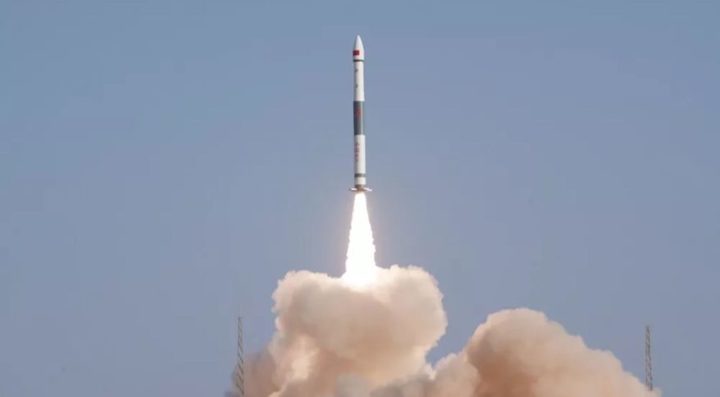
HELSINKI — China carried out its second orbital launch in just over 24 hours late Wednesday, sending the Yinhe-1 commercial 5G satellite into low Earth orbit.
A Kuaizhou-1A solid launch vehicle lifted off from a mobile platform at the Jiuquan Satellite Launch Center in northwest China at 10:02 p.m. Eastern.
Aboard was the 227-kilogram Yinhe–1 (Galaxy-1) technology verification satellite for Beijing-based communications satellite producer Galaxy Space. Yinhe-1 is expected to test Q/V and Ka band communications at up to 10 Gbps in a target orbit of about 1,156 kilometers.
The satellite, also referred to as GS-SparkSat-03, is part of plans to establish a global 5G constellation based on the ‘low-cost, high-performance’ Galaxy-1 small satellite platform. The platform will be refined based on lessons from on-orbit testing.
Galaxy Space plans to launch 144 satellites for the constellation across the next three years. The firm wants to provide high-speed, low-latency communications services globally, including remote areas.
The satellites have been developed with assistance from the China Aerospace Science and Technology Corporation (CASC) and the China Electronics Technology Group Corporation (CETC). The firm has earlier stated that the satellites will be capable of deorbiting near the end of the design lifetime.
Galaxy Space, founded in 2016 by Xu Ming, announced in September that it had secured new fundingin a series B round.
Kuaizhou-1A launch cadence
The Kuaizhou-1A is operated by Expace, a commercial subsidiary of the China Aerospace Science and Industry Corporation (CASIC), a giant defense contractor and missile maker.
The launcher is understood to be derived from missile technology. It consists of three solid stages and a liquid propellant upper stage and is capable of delivering a 200-kilogram payload into a 700-kilometer sun-synchronous orbit (SSO).
The 20-meter-long Kuaizhou-1A is restricted to launch commercial payloads. Main space contractor CASC launches China’s government and military payloads. CASC has its own solid fuel launcher in the Long March 11 which entered service in 2015.
The Kuaizhou-1A has now launched eight times since its inaugural mission in 2017, and six times since August. Expace is preparing to test launch the larger Kuaizhou-11 which may lift as much as 1,000 kilograms to 700-kilometer SSO.
CASIC has its own plans to establish LEO communications constellations, with the Hongyun wideband and Xingyun narrowband projects.
Chinese NewSpace startups have emerged following a late 2014 central government policy shift. This has brought the opening up of the launch and small satellite sectors to private capital.
Chinese publication Future Aerospace reported last year that there were 141 registered commercial aerospace companies in China at the end of 2018. These are spread across launch services, satellite manufacturing and applications, ground stations and other areas. The companies have been aided by the ‘civil-military fusion’ national strategy.
State-run spinoff Expace and private firms including Landspace, iSpace, OneSpace, Linkspace and Galactic Energy are developing launch vehicles with the aim of providing low-cost launch services domestically and beyond.
China’s 2020 launch plans
The Wednesday mission was China’s third of 2020. Yinhe-1 follows the launch of the classified TJS-5 satellite to GTO from Xichang and a Long March 2D from Taiyuan sending four satellites to LEO late Tuesday. The latter mission included two new ÑuSats for Argentina-based remote sensing firm Satellogic.
CASC is planning more than 40 launches in 2020, with commercial and private launches potentially taking China’s overall launch figures to over 50 this year.
SpaceX kicked off 2020 globally with the launch of 60 Starlink satellites, making the company the operator of world’s largest commercial satellite constellation.
Quelle: SN
+++
Kuaizhou-1A lofts Yinhe-1 for China
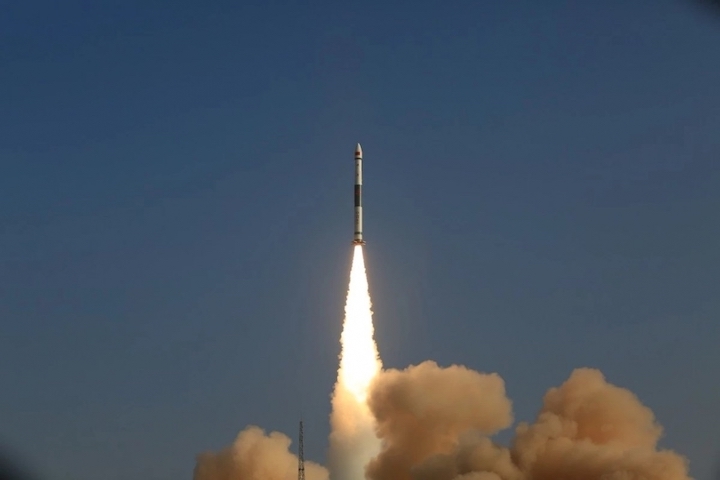
China conducted its second orbital launch in 2020 orbiting the first test technology demonstration satellite for a 5G constellation, named Yinhe-1. Launch took place at 03:00UTC on January 16 using the Kuaizhou-1A (Y9) from the Jiuquan Satellite Launch Center.
Also designated GS-SparkSat-03, the 227 kg Yinhe-1 satellite will be operated by GalaxySpace, a Beijing-based communications satellite producer. This Chinese company was founded in 2016 with the aim to mass produce low-cost, high-performance small satellite through agile and fast-iterative development mode, and to build the world’s leading LEO broadband satellite constellation with a global coverage with 5G communication network. The satellite provides a communication bandwidth of 10Gbps.
The satellites are developed in collaboration with the China Aerospace Science and Technology Corporation (CAST), with the China Aerospace Science and Industry Corporation (CASIC) and with the China Electronics Technology Group Corporation (CETC).
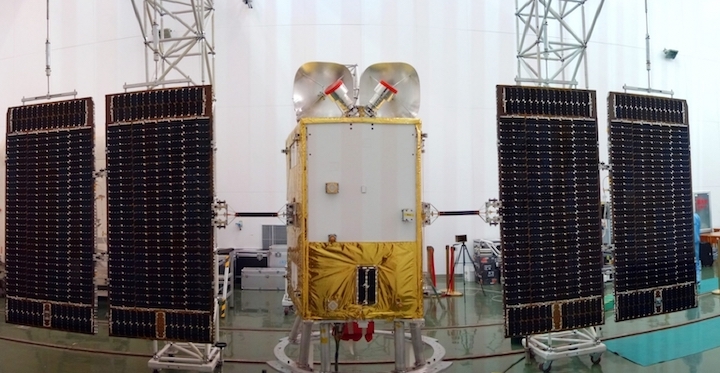
The mission is to improve the network connection condition of all regions and individuals, and to provide cost-effective, efficient and convenient broadband networks and services, while providing more accessible knowledge, more equal and extensive information, simpler and convenient communication and more development opportunities for everyone.
The company’s core team consists of senior experts from the Internet, aerospace industry and scientific research institutions. With the strength of satellite technology research and development capabilities as the basis, and combining with Internet Thinking, GalaxySpace can provide users with quality Internet service and experience.
The low-cost and high-performance small communication satellites developed by Galaxy Space, have the characteristics of modular components, lighter weight structure, and intelligent and mass manufacturing. When the Galaxy constellation satellite approaches the end of its service time, the satellite will automatically perform maneuvers and then burn out in the atmosphere.
The constellation will consist of up to 1,000 communication satellites deployed on 500 km-1000 km Low Earth Orbits, seamlessly expanding the terrestrial communication networks, covering all regions of lands, oceans and sky. Aligning with 5G standards, the constellation will allow users to access 5G networks with high speed and flexibility, using small, intelligent, low-cost satellite user terminals that are suitable for use in schools, homes, automobiles, aircrafts and many other scenarios.
The small, intelligent, and low-cost satellite user terminal, working with the satellite communication system, provides an economical, practical, stable and convenient network, allowing users to access the Internet at high speed efficiently. The user terminal is easy to install and use, and can be customized and equipped with solar self-powered expansion modules and AI voice control optionally.
The services provided by GalaxySpace will help in infrastructure construction in remote rural areas of both developed countries and developing countries. Due to dispersed population distribution, some working, living, educational or medical establishments have no or unstable access to terrestrial network. Quick and convenient access to satellite network solves those problems effectively, which brings more opportunities and security.
GalaxySpace provides low latency 5G satellite network infrastructure and services for automobiles, aircrafts, navigations and remote land transportations. With small intelligent low-cost satellite user terminals,customers can quickly connect to satellite communication network at any time and from anywhere.
The service is based on a stable, safe and fast dedicated satellite communication network for the sites which have no access to terrestrial communication networks, including business outlets, R&D bases, production sites, institutions, checkpoints, observatories, and other facilities with massive data-uploading demand. It will provide satellite constellation and overall dedicated satellite network solutions to enterprise and government customers all over the world.
With 5G standards adoption, LEO communication satellite constellation provides world-wide space-based 5G services; connects to terrestrial 5G network transparently so that users could switch serving networks seamlessly; provides backhaul path for terrestrial 5G base stations.
The new Galaxy satellite constellation will provide swift and timely network deployment or long-term access solutions to cope with regional disasters and temporary communications needs. It will help telecom operators to connect their terrestrial base stations in isolated or remote areas and the satellite user terminal can satisfy network access demand in scientific investigation, exploration and other activities in extreme and severe environments.
Via Galaxy satellite constellation, status and information of global scale IoT networks can be accessed, monitored, transmitted and shared in a real-time, seamless and secure way.
Like previous Kuaizhou-1A launches, the orbiting of YInhe-1 was managed by Expace. Expace Technology Co., Ltd., a subsidiary of China Aerospace Science & Industry Corp, it is specialized in R&D, manufacturing and marketing of the Kuaizhou series launch vehicle to provide cost-effective, reliable and accurate commercial launch service for customers all over the world.
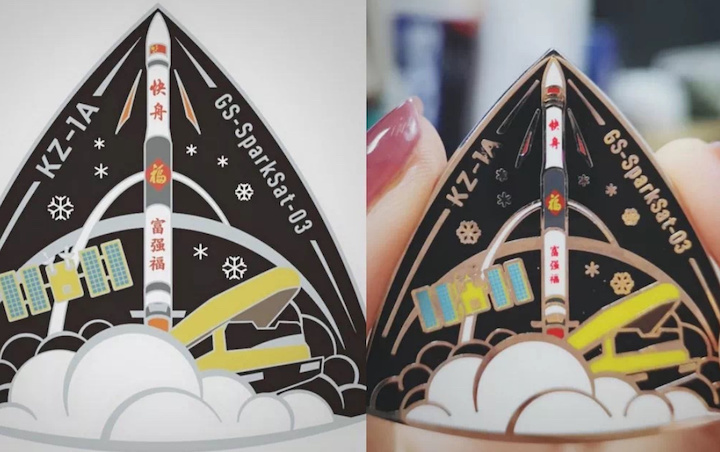
The Kuaizhou-1A is a high reliability, high precision and low-cost solid launch vehicle developed by China Aerospace Science and Technology Corporation (CASIC) and commercialized by the China Space Sanjiang Group Corporation (Expace).
The launch vehicle can send a 200kg payload into a 700km sun-synchronous orbit. It mainly offers the service of sending a small satellite into Low Earth Orbit (LEO) to domestic and international customers.
The vehicle is possible based on the road-mobile DF-21 missile adding two additional upper stages. There are no apparent differences between the KZ-1A (previous commercially available as the FT-1 Feitian-1) and the KZ-1 launch vehicle.
The difference, though, can be explained by the fact that with KZ-1 the payload remains attached to the fourth liquid stage, while the KZ-1A is used for multiple payloads.
The KZ-1A solid launch vehicle adopts a mobile launch platform, integrated power supply equipment, test and launch control facilities, aiming facility and temperature control facility, to carry vehicles from the technical support center to launch site, complete temperature control of payload, vehicle test and launch.
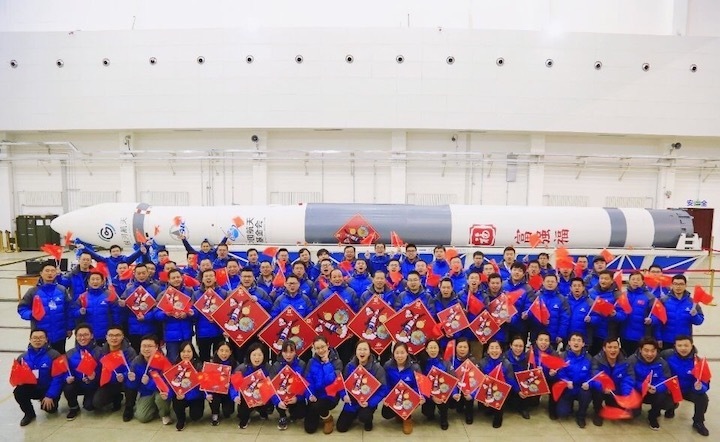
KZ-1A launch vehicle is 20 meters long with a lift-off mass of 30 tons, and its maximum diameter is 1.4 meters. The vehicle’s power is provided by three solid motors and one liquid motor.
The solid propulsion system consists of three solid vehicle motors to provide power during first stage flight, second stage flight and third stage flight. All of the three solid motors use a single fixed nozzle and do not shut off until the propellant is exhausted.
The first stage motor is 1,40 meters in diameter, having a total mass of 16,621 kg, a burn time of 65 seconds and an impulse of 2,352 Ns/kg. The Second stage motor is 1,40 meters in diameter, having a total mass of 8,686 kg, a burn time of 62 seconds and an impulse of 2,810 NS/kg. The Third stage motor is 1,20 meters in diameter, having a total mass of 3,183 kg, a burn time of 55 seconds and an impulse of 2,850 NS/kg.
The vehicle can be used with two kinds of fairings having a diameter of 1.2 and 1.4 meters according to the space demand of cargo to be orbited.
KZ-1A is launched from a mobile platform. The Mobile Launch Platform mainly includes transport and launch vehicles, test and fire control equipment, aiming equipment, etc.
The MLP transfers the vehicle from technological area to launching area, also providing temperature and environment control of payload, vehicle test and launching by using power supply equipment, test and fire control equipment, aiming equipment, temperature control devices, which are integrated into the platform. The transport and launch vehicle employs a semi-trailer which is usually used for transporting containers.
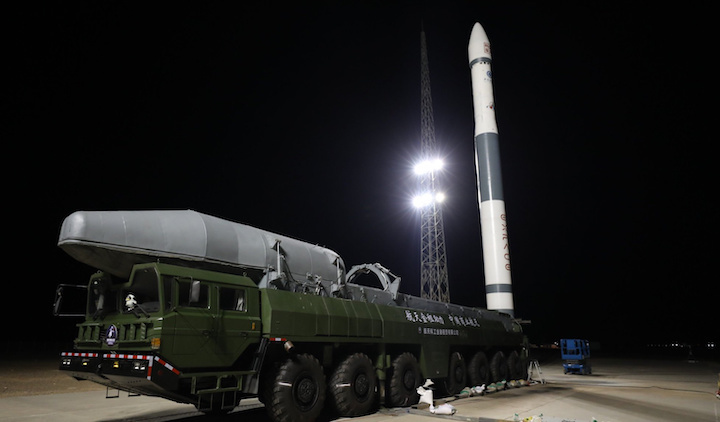
The usual launch profile sees the first stage separation taking place 1 minute and 23 seconds after launch. The second stage separation takes place at 2 minutes 21 seconds after launch, and the fairing jettisoning 15 seconds after second stage separation.
Ignition of the third stage occurs at 192 seconds into the flight, ending 1 minute 32 seconds later. Three seconds after third stage separation, the fourth and last stage gives the last kick into orbit, with a burn duration of 12 minutes and 45 seconds. Spacecraft separation takes place 17 minutes and 40 seconds after launch.
The first launch of the Kuaizhou-1A launch vehicle orbited the Jilin Linye-1 forestry satellite and two small CubeSats-2U: the Xingyun Shiyan-1 and the Kaidun-1 ‘Caton-1’. Launch took place on January 9, 2017, from the Jiuquan Satellite Launch Center.
The Jiuquan Satellite Launch Center, in Ejin-Banner – a county in Alashan League of the Inner Mongolia Autonomous Region – was the first Chinese satellite launch center and is also known as the Shuang Cheng Tze launch center.
Jiuquan was originally used to launch scientific and recoverable satellites into medium or low earth orbits at high inclinations. It is also the place from where all the Chinese manned missions are launched.
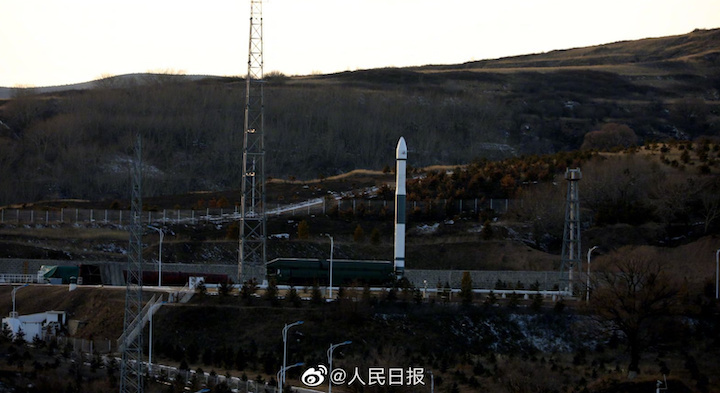
The site includes a Technical Centre, two Launch Complexes, Mission Command and Control Centre, Launch Control Centre, propellant fuelling systems, tracking and communication systems, gas supply systems, weather forecast systems, and logistic support systems.
The LC-43 launch complex, also known as South Launch Site (SLS) is equipped with two launch pads: 91 and 94. Launch Pad 91 is used for the manned program for the launch of the Long March-2F launch vehicle (Shenzhou and Tiangong). Launch Pad 94 is used for unmanned orbital launches by the Long March-2C, Long March-2D and Long March-4C launch vehicles.
Other launch zones at the launch site are used for launching the Kuaizhou, the CZ-11 Chang Zheng-11 and other solid propellant commercial / private launch vehicles.
The first orbital launch took place on April 24, 1970 when the CZ-1 Chang Zheng-1 rocket launched the first Chinese satellite, the Dongfanghong-1 (04382 1970-034A).
Quelle: NS
